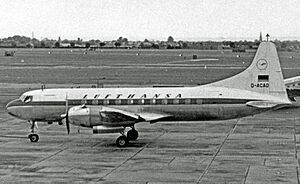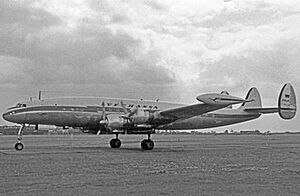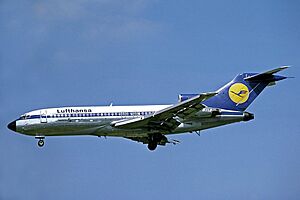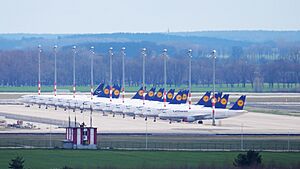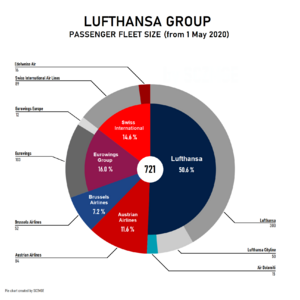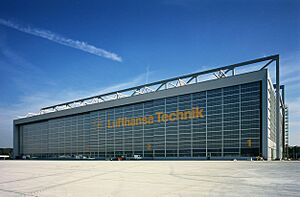Lufthansa facts for kids
A Lufthansa Airbus A350-900
|
|
| Founded | 1953 |
|---|---|
| Commenced operations | 1955 |
| Hubs | |
| Frequent-flyer program | Miles & More |
| Alliance | Star Alliance |
| Fleet size | 274 |
| Destinations | 229 |
| Parent company | Lufthansa Group |
| Headquarters | Cologne, North Rhine-Westphalia, Germany |
| Key people | |
| Revenue | |
| Operating income | |
| Net income | |
| Total assets | |
| Total equity | |
| Employees | |
|
Trade name
|
Lufthansa Group |
|---|---|
| Public | |
| Traded as | FWB: LHA |
| Founded | 6 January 1953 |
|
Key people
|
|
| Subsidiaries |
|
Deutsche Lufthansa AG, often called the Lufthansa Group, is a big German aviation company. Its main airline, Lufthansa German Airlines, or just Lufthansa, is Germany's national airline. It carries the second-most passengers in Europe. It is also the largest airline in Europe and fourth largest in the world by how much money it makes. Lufthansa is one of the five airlines that started Star Alliance in 1997. This is the world's largest group of airlines working together.
Lufthansa started in 1953 and began flying in April 1955.
Besides flying planes under its own name, the Lufthansa Group also owns other airlines. These include Austrian Airlines, Brussels Airlines, Discover Airlines, Eurowings, ITA Airways and Swiss International Air Lines. The group also owns companies that help with flying. Some of these are Global Load Control, Lufthansa Consulting, Lufthansa Flight Training, Lufthansa Systems and Lufthansa Technik.
The company was first called Aktiengesellschaft für Luftverkehrsbedarf (or Luftag). It was started on January 6, 1953. Many of its first workers came from the old German national airline, Deutsche Luft Hansa. That airline was closed in 1951. Luftag bought the name and logo of Luft Hansa in 1954. This helped it continue the tradition of a German national airline.
Lufthansa's main office is in Cologne, Germany. Its main operations are at Frankfurt Airport. This airport is the airline's primary hub, which means it's a central point for many flights. Lufthansa also has a second hub at Munich Airport.
Contents
Lufthansa's Journey Through Time
Starting After the War (1950s)
Lufthansa's story goes back to 1926. That's when Deutsche Luft Hansa was formed in Berlin. It was created by joining two other airlines. Deutsche Luft Hansa was Germany's national airline until World War II. After the war, all planes in Germany were taken. Deutsche Luft Hansa was then closed down.
To create a new national airline, a company called Aktiengesellschaft für Luftverkehrsbedarf (Luftag) was started. This happened in Cologne, West Germany, on January 6, 1953. Many people who worked there had been with the old Deutsche Luft Hansa.
In 1953, Luftag ordered its first planes. These included Convair CV-340 and Lockheed L-1049 Super Constellation aircraft. On August 6, 1954, Luftag bought the name and logo of the old Deutsche Lufthansa. This helped it carry on the tradition.
On April 1, 1955, Lufthansa was allowed to start flying. Its first flights were between German cities. International flights began on May 15, 1955. These went to places like London, Paris, and Madrid. Later, flights to New York City started in June 1955.
At that time, Germany was divided. Lufthansa was not allowed to fly to Berlin. Because of this, Lufthansa made Frankfurt Airport its main hub in 1958.
The Jet Age Begins (1960s)
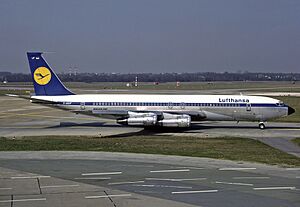
Lufthansa started using jet planes in 1958. They ordered four Boeing 707 aircraft. This was a big step forward. It allowed them to start jet flights between Frankfurt and New York City in March 1960.
Lufthansa's network grew in the early 1960s. By February 1961, flights went to Hong Kong and Tokyo. In 1962, they added flights to Africa, including Lagos and Johannesburg.
The Boeing 727 was introduced in 1964. This allowed Lufthansa to start a new route over the North Pole. This flight went from Frankfurt to Tokyo via Anchorage. In 1965, they ordered twenty-one Boeing 737 aircraft. These planes started flying in 1968.
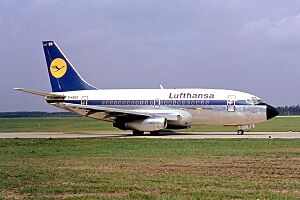
Lufthansa was the very first airline to buy the Boeing 737. This was a special moment for both Lufthansa and Boeing.
Bigger Planes and New Ideas (1970s–1980s)
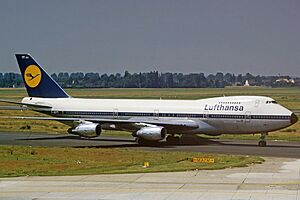
Lufthansa started using very large planes, called wide-body aircraft, in 1970. The first was a Boeing 747. Then came the DC-10-30 in 1974. The first Airbus A300 joined the fleet in 1976. In 1979, Lufthansa and Swissair were the first to order the Airbus A310.

In 1985, Lufthansa ordered many new planes for the 1990s. These included Airbus A320s and Airbus A300-600s. They also bought Boeing 737-300s. Later, they added Airbus A321, Airbus A340, and Boeing 747-400 aircraft.
In 1987, Lufthansa helped create Amadeus. This company helps travel agencies book flights easily. In 1988, Lufthansa changed its look. Planes got new paint, and offices were redesigned.
Growing Bigger (1990s–2000s)
After Germany became one country again in 1990, Lufthansa quickly started flying to Berlin.
In the mid-1990s, Lufthansa changed how it was organized. It created separate companies for different jobs. These included Lufthansa Technik for plane repairs, Lufthansa Cargo for shipping goods, and Lufthansa Systems for computer technology.
Lufthansa joined Star Alliance on May 18, 1997. This was the world's first big airline alliance. Other airlines like Air Canada and United Airlines were also part of it.
In the early 2000s, Lufthansa stayed strong even when other airlines struggled. They kept making money and did not cut jobs after the September 11 attacks. In 2004, Lufthansa was the first to offer internet on flights through Connexion by Boeing.
Lufthansa grew by buying other airlines. They bought Swiss International Air Lines in 2005. They also bought Brussels Airlines and Austrian Airlines in 2009. This helped them reach more places.
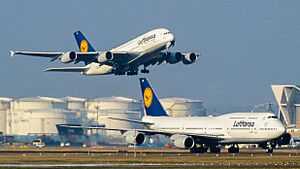
Towards the end of the 2000s, Lufthansa bought many very large planes. They got their first Airbus A380 in 2010. They were also the first to buy the Boeing 747-8I in 2012.
Challenges and Changes (2010s)
In 2011, Lufthansa planned to grow a lot at Berlin Brandenburg Airport. However, the airport's opening was delayed.
Lufthansa faced financial challenges in the early 2010s. They started a plan called SCORE to improve profits. As part of this, they moved many short flights to their low-cost airline, Germanwings.
In September 2013, Lufthansa Group made its biggest order ever. They bought 59 large aircraft. Earlier that year, they ordered 100 smaller, new-generation planes.
Lufthansa had disagreements with its pilot union. This led to several strikes. For example, in April 2014, pilots went on strike for three days. This caused many flights to be canceled.
During the 2014 FIFA World Cup, some Lufthansa planes were painted with "Fanhansa" to support the German team.
In October 2017, Lufthansa bought 81 planes from Air Berlin, another airline that was closing down.
On December 4, 2017, Lufthansa became the first European airline to get a 5-star rating from Skytrax. This rating is for excellent service. To celebrate, Lufthansa painted some planes with "5 Starhansa."
In March 2019, Lufthansa ordered 20 Boeing 787-9 and 20 Airbus A350-900 planes. They also announced they would sell six A380 aircraft back to Airbus starting in 2022.
The Pandemic and Recovery (2020s)
On March 19, 2020, Lufthansa canceled 95 percent of its flights. This was because of travel bans during the COVID-19 pandemic. The airline lost a lot of money, about 1 million euros every hour in April 2020.
On May 14, Lufthansa Group announced it would start flying more. They planned 1,800 flights per week by the end of June. All passengers on Lufthansa Group flights had to wear a mask.
On June 25, 2020, Lufthansa shareholders agreed to a 9 billion euro bailout from the German government. This helped the airline survive. The government got a 20% share in the airline.
In January 2021, Lufthansa said it would remove its Airbus A340-600 fleet. But this decision was later changed, and some A340-600s returned to service. In June 2021, Lufthansa said it would use more gender-neutral language in its announcements, like not saying "Ladies and Gentlemen."
In January 2022, Lufthansa said it had flown over 18,000 empty flights. This was to keep their airport slots during the pandemic.
In March 2022, Lufthansa first said its entire Airbus A380 fleet would be retired. But in June 2022, they changed their mind. They planned to bring up to five A380s back into service by 2023.
In May 2022, Skytrax changed Lufthansa's rating from 5-star to 4-star.
In 2023, an IT problem affected Lufthansa. This caused many passengers to be stuck around the world. The issue was caused by construction work cutting fiber optic cables.
In May 2023, Lufthansa Group agreed to buy a 41% share in ITA Airways, Italy's national airline. This deal also allows Lufthansa to buy the rest of the shares later.
How Lufthansa Works
Who Owns Lufthansa
Lufthansa was owned by the government until 1994. Since 1966, anyone can buy shares in Deutsche Lufthansa AG on German stock exchanges. Most of the shares are owned by German investors. Large investment companies like Lansdowne Partners and BlackRock are also big shareholders.
German Government Help
The German government gave Lufthansa 9 billion euros to help it during the COVID-19 pandemic. This increased the government's share in the airline to 20%. The company's shareholders approved this help on June 26, 2020.
Lufthansa's Family of Airlines
Lufthansa has many other airlines that are part of its group:
- Network Airlines: These are national airlines that fly to many places.
- Lufthansa Airlines: The main airline, based in Frankfurt and Munich.
- Austrian Airlines: Austria's national airline.
- Swiss International Air Lines: Switzerland's national airline.
- Brussels Airlines: Belgium's national airline.
- ITA Airways: Italy's national airline. Lufthansa Group owns 41% of it.
- airBaltic: Latvia's national airline. Lufthansa Group owns 10% of it.
- Feeder Airlines: These airlines fly shorter routes to bring passengers to the main Lufthansa flights.
- Lufthansa CityLine: A German regional airline.
- Lufthansa City Airlines: A new regional airline that started in June 2024.
- Air Dolomiti: An Italian regional airline.
- Low-cost Airlines: These airlines offer cheaper flights, often without many extras.
- Eurowings: A German low-cost airline.
- Eurowings Europe: A low-cost airline based in Malta.
- Leisure Airlines: These airlines focus on flights for vacations.
- Discover Airlines: A German airline for long and medium-haul leisure flights.
- Edelweiss Air: A Swiss leisure airline, part of Swiss International Air Lines.
- Cargo Airlines: These airlines carry goods instead of people.
- Lufthansa Cargo: A German cargo airline.
- Joint Ventures: These are airlines owned together with other companies.
- AeroLogic: A German cargo airline owned with DHL.
- SunExpress: A Turkish leisure airline, owned with Turkish Airlines.
Other Lufthansa Companies
Lufthansa also has other companies that help with aviation:
- Global Load Control: Helps with how weight is balanced on planes.
- Lufthansa Consulting: Gives advice to other airlines and airports.
- Lufthansa Flight Training: Trains pilots for Lufthansa and other airlines.
- Lufthansa Systems: The biggest European company for aviation IT (computer systems).
- Lufthansa Technik: Fixes and maintains aircraft.
Lufthansa's Look and Slogan
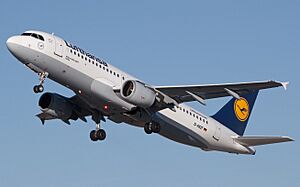
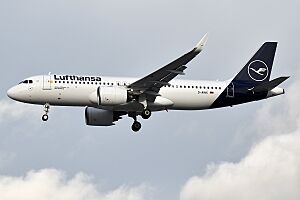
The Lufthansa logo is a crane bird flying inside a circle. It was first designed in 1918. The old German airline, Deutsche Luft-Reederei, used it first. In 1926, Deutsche Luft Hansa adopted it. Lufthansa kept this symbol in 1954 to show it was continuing the tradition.
The name "Lufthansa" comes from a book written in 1925. "Luft" means air, and "Hansa" refers to a group of trading cities in medieval Germany.
After World War II, Lufthansa kept blue and yellow as its main colors. The crane logo stayed. In 1967, a designer named Otl Aicher created a new look. The crane logo was always in a yellow circle on a blue tailfin.
In 2018, Lufthansa changed its look again. The crane logo stayed, but the yellow background became dark blue. The tail and back of the plane are now dark blue. The rest of the plane is white.
Lufthansa's slogan is 'Say yes to the world.'
Working with Others
Lufthansa works with many other airlines. They have agreements to share flights (called codesharing) and let passengers earn frequent flyer miles on each other's flights.
Lufthansa is part of Star Alliance. This is a big group of airlines that work together around the world.
Lufthansa also has joint ventures with other airlines. For example, they work with All Nippon Airways and Singapore Airlines on flights.
Lufthansa sponsors the German football club Eintracht Frankfurt. They also support the German Sports Aid Foundation.
Buying ITA Airways
On May 25, 2023, Lufthansa signed a deal to buy 41% of ITA Airways, Italy's national airline. Lufthansa paid 325 million euros for this share. They also have the option to buy the rest of the company later. This deal means Rome will become a new hub for the Lufthansa Group.
Where Lufthansa Flies
Lufthansa flies to many places around the world. They have agreements with other airlines to make it easier for you to travel.
Lufthansa has agreements to share flights with many airlines. This means you can book a flight with Lufthansa, but part of your journey might be on a plane from another airline. Some of these partners include:
- Air Canada
- Air China
- Air India
- Air New Zealand
- Austrian Airlines
- Brussels Airlines
- Eurowings
- ITA Airways
- LOT Polish Airlines
- South African Airways
- Swiss International Air Lines
- TAP Air Portugal
- Thai Airways International
- Turkish Airlines
- United Airlines
Lufthansa's Planes
Naming Aircraft
In 1960, Lufthansa started naming its planes after German cities and towns. For example, a Boeing 707 was named Berlin. This tradition continued for many years. The size of the plane often matched the importance of the city.
There were a few exceptions. One Airbus A340-300 was named "Gander/Halifax" after two Canadian cities. This was to remember their kindness during the September 11, 2001 attacks, when many planes had to land there unexpectedly. Another plane was named Finkenwerder after the place where Airbus planes are made.
In 2010, Lufthansa started naming its Airbus A380s after its main airports, like Frankfurt am Main and München. Later A380s were named after other Lufthansa Group hubs or major cities around the world.
Restoring Old Planes
Lufthansa Technik, the part of Lufthansa that fixes planes, has restored old aircraft. They brought a Junkers Ju 52/3m from 1936 back to flying condition. They are also restoring a Lockheed Super Constellation.
The Airbus A380
Lufthansa first ordered fifteen Airbus A380-800 planes. The A380 is a very large, double-deck airplane. In March 2019, Lufthansa announced it would remove six A380s from its fleet. These planes were sold back to Airbus.
On March 8, 2020, Lufthansa stopped flying all its A380s because of the COVID-19 pandemic.
However, on June 27, 2022, Lufthansa announced that the remaining eight A380s would return to service for the summer of 2023. This was because more people wanted to travel, and new Boeing 777-9 planes were delayed.
The first A380 to return to service was D-AIMK. It flew from storage in Spain to Frankfurt in December 2022. After more maintenance, it started flying paying passengers again on June 1, 2023, from Munich to Boston.
By September 2024, Lufthansa had brought back its eighth and last A380. In 2025, these A380s will fly from Munich to cities like Bangkok, Boston, Delhi, Denver, Washington-Dulles, New York-JFK, and Los Angeles.
What Lufthansa Offers
Miles & More Program
Lufthansa has a program for frequent flyers called Miles & More. You can earn miles when you fly with Lufthansa or its partner airlines. You can also earn miles with Lufthansa credit cards or by shopping at Lufthansa stores. These miles can be used for free flights or other rewards.
There are different levels in Miles & More. The higher levels give you special benefits, like access to airport lounges.
Different Seating Classes
Lufthansa offers different types of seats, or "cabins," on its planes:
First Class
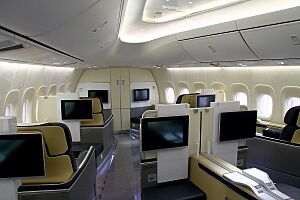
First Class is the most luxurious. It's available on some Airbus A340-600s, Airbus A380s, and Boeing 747-8s. Each seat turns into a comfortable bed. You also get power outlets for your devices and entertainment. Meals are served whenever you want them. Lufthansa has special check-in areas and lounges just for First Class passengers. In Frankfurt, they even have a special First Class terminal.
In October 2022, Lufthansa showed off a new First Class design. It will be on new A350 planes starting in 2023.
Business Class
Business Class is on all long-haul planes. Seats can become flat beds. They also have power outlets and entertainment. Lufthansa has special check-in counters and lounges for Business Class passengers at most airports. In 2014, all wide-body planes had lie-flat seats in Business Class. Lufthansa plans to introduce a new Business Class in 2023 on some new planes.
Premium Economy
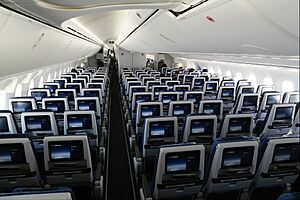
Premium Economy was introduced in 2014. It's available on all long-haul planes. These seats have more legroom and are wider than regular Economy seats. They also have a personal entertainment screen.
Bus Service
Lufthansa offers a bus service from Nuremberg Airport to Munich Airport. This bus service started again in 2021. It helps replace short flights between these two cities.
Plane Incidents
This section lists accidents and incidents involving Lufthansa's main planes since 1956.
Serious Incidents
- On January 11, 1959, Lufthansa Flight 502, a Lufthansa Lockheed Super Constellation, crashed near Rio de Janeiro-Galeão International Airport in Brazil. Only 3 people out of 39 survived. The pilots were blamed for flying too low.
- On December 4, 1961, a Lufthansa Boeing 720 crashed near Mainz during a training flight. All three people on board died.
- On July 15, 1964, another Boeing 720 crashed during a training flight near Ansbach. All three people died.
- On January 28, 1966, Lufthansa Flight 005, a Convair CV-440 Metropolitan, crashed near Bremen Airport. All 42 passengers and 4 crew members died. The plane stalled while trying to go around for another landing attempt.
- On November 20, 1974, Lufthansa Flight 540, a Boeing 747-100, crashed shortly after takeoff at Jomo Kenyatta International Airport in Kenya. This was the first accident involving a Boeing 747. 55 passengers and 4 crew members died.
- On July 26, 1979, a Lufthansa cargo Boeing 707 crashed into a mountain near Rio de Janeiro during takeoff. All three crew members died. This was due to a mistake in communication.
- On September 14, 1993, Lufthansa Flight 2904, an Airbus A320-200, went off the runway when landing at Warsaw Chopin Airport in Poland. The co-pilot and one passenger died.
Other Incidents
- On December 20, 1973, a Lufthansa Boeing 707 collided with a small building near Indira Gandhi International Airport in India. No one was hurt, but the plane was badly damaged.
- On June 11, 2018, a Lufthansa Airbus A340-300 caught fire while being moved at Frankfurt Airport. The front of the plane was damaged. Six people were treated for breathing in smoke.
- On March 1, 2023, Lufthansa Flight 469, an Airbus A330-343, experienced sudden turbulence over Tennessee. The flight was diverted, and seven passengers were taken to the hospital.
Plane Hijackings
- In 1972, there were four hijackings involving Lufthansa planes.
- On February 22, Lufthansa Flight 649, a Boeing 747-200, was hijacked by five terrorists. They demanded money from the German government. The plane landed in Yemen, and the hostages were released after the money was paid.
- On October 29, Lufthansa Flight 615, a Boeing 727, was hijacked. The hijackers wanted to free some prisoners. The plane was flown to several airports before the prisoners were released, and the hostages were freed in Libya.
- On December 17, 1973, a parked Lufthansa Boeing 737-100 was hijacked at Leonardo da Vinci-Fiumicino Airport in Rome. The hijackers forced the crew to fly to several airports before surrendering in Kuwait.
- The hijacking of the Landshut happened on October 13, 1977. A Boeing 737-200 was hijacked by four terrorists. They wanted to free other terrorists. The plane was flown to many places, and the captain was killed. German special forces stormed the plane in Somalia and freed all the hostages.
- On February 11, 1993, Lufthansa Flight 592, an Airbus A310, was hijacked by a man who wanted to stay in the United States. He surrendered when the plane landed in New York City. No one was hurt.
Customer Concerns
Incident with Passengers
In May 2022, there was an incident on a Lufthansa flight from New York to Frankfurt. Some passengers did not follow rules about wearing masks. Because of this, Lufthansa stopped over a hundred passengers from boarding a connecting flight. Lufthansa later said it was an "unfortunate series of inaccurate communications" and denied that its actions were discriminatory. In October 2024, Lufthansa paid a penalty to the US Department of Transportation related to this event.
See also
 In Spanish: Lufthansa para niños
In Spanish: Lufthansa para niños
- Air transport in Germany
- List of airlines of Germany
External links
- Documents and clippings about Lufthansa in the 20th Century Press Archives of the ZBW


